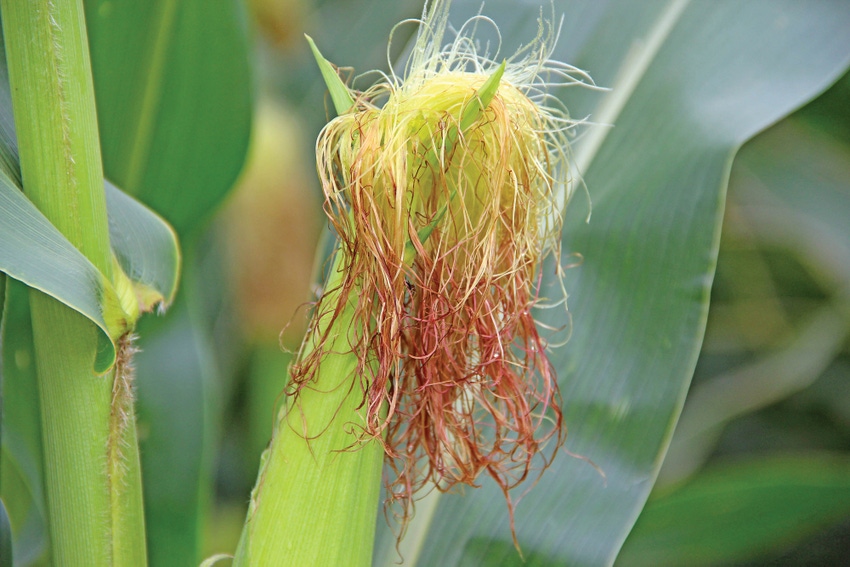June 21, 2012

Arkansas’ corn, soybean and cotton farmers are seeing unprecedented precocity their 2012 crops. While the fields look good, agronomists with the University of Arkansas Division of Agriculture warn there’s still a lot of time between now and harvest.
According to Monday’s crop report from the National Agricultural Statistics Service, Arkansas’ corn, soybean, cotton and sorghum crops were running well ahead of the five-year average in stages of development.
Soybeans
Soybeans were nearly all planted at 98 percent, and 7 percent of the plants were already setting pods. That’s so early there is no five-year average. Digging back in the NASS records, there’s no precedent in the last 10 years either, with the earliest pods appearing in the July 9, 2006 report.
“If everything keeps going like it has so far this year, we could be harvesting two to three weeks earlier,” Jeremy Ross, Extension soybean agronomist, said June 19. “We usually start harvesting around the first of September, and we are generally halfway through harvest by mid-October. I would guess we will be harvesting some soybean fields by mid-August this year.”
Earliness is a much-desired quality in soybeans “to avoid late-season stress from drought, insect and disease pressure,” he said. “But we have already had droughty conditions and heavy insect pressure this year.
“If this year is like last year, we could have heavy insect pressure later in the year, and some of these early-planted fields may avoid the late season pressure. If we can catch a few rain showers in the next six to eight weeks, we could possibly avoid an irrigation or two on these early beans as well.”
Cotton
Cotton was 85 percent squared, or setting flower buds, compared with the 38 percent five-year average. Five percent of the crop was setting bolls. Last year and the five-year average showed no bolls at this time of year.
Tom Barber, Extension cotton agronomist, said cotton was “at least three weeks ahead of schedule, maybe more in some areas.”
�“Seventy-five percent of our crop looks good at this time, but the remaining 25 percent struggled to get a stand and has had severe issues with thrips, damage from pre-emerge herbicides and dry weather.
“The rainfall received last week was a huge blessing where it fell,” Barber said. “Unfortunately it didn’t fall everywhere and water and irrigation timing is crucial at this point because a large majority of our cotton will be blooming soon, if not already.”
Water and nutrient demands escalate at an exponential rate the first, second and third weeks of bloom during peak boll fill.
Farmers are scouting and finding plant bugs in some acres, but “they don’t seem to be terrible everywhere, at least right now,” Barber said. “We anticipate a heavy bollworm flight out of corn. So, we will need to watch that close. Spider mites are also picking up in scattered areas of the state.
“All things considered we have a fairly good looking crop but we still have a long way to go.”
Corn
Ninety-four percent of corn was silking, well ahead of the 44 percent five-year average and also ahead of last year’s 48 percent. Two percent was at dent, the second-to-last stage before the corn is mature enough to harvest. Reaching dent this early is unprecedented in the last five years.
“The warm weather March through June has really pushed the corn crop along,” said Jason Kelley, Extension agronomist. “We had the warmest March on record, which aided in early planting and allowed early planted corn to emerge and grow quickly.”
All season the crop has been two to three weeks ahead of schedule.
“We don't have any corn that is mature yet, but by early July some of our early-planted corn in south Arkansas could be mature, which would be the earliest that anyone can remember. We will likely be harvesting a decent amount of corn in July this year.”
Rice, sorghum
Sorghum doubled its heading, with 28 percent reported at that stage, up from 14 percent the previous week and well ahead of the 2 percent five-year average. Extension entomologist Glenn Studebaker said sorghum midges were appearing and growers should start scouting when 20 percent of the field is flowering.
Rice is 9 percent headed. Last year and the five year average were zero percent.
Sorghum was 28 percent headed, double the previous week’s rate and well ahead of the 2 percent five year average.
Rainless day after rainless day meant irrigation returned to the forefront for farmers, said Robert Goodson, Extension agent in Lee and Phillips counties. “We got anywhere from 1.5 to 3 inches and even those who got the 3 inches of rain last Monday and Tuesday are irrigating now.”
To learn more about crop production, contact your county Extension office, or visit www.uaex.edu and arkansascrops.com.
You May Also Like




